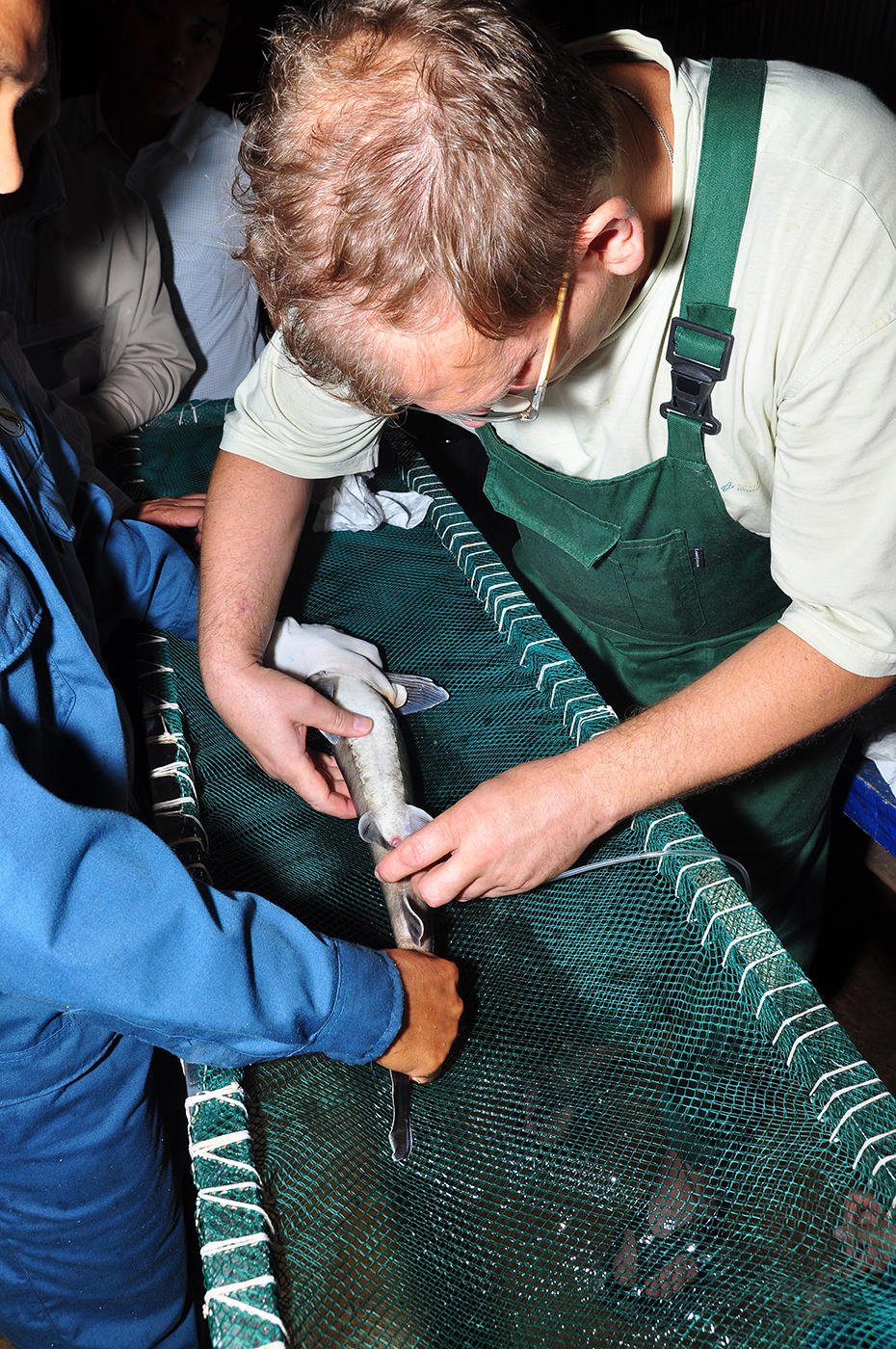Sturgeon
The various species of sturgeon live in the fresh waters of the northern hemisphere and are reputed for their eggs, called caviar. Sturgeons can grow up to 6 metres in length, weigh over 100 kilograms and live for over 100 years. In the past, the females were slaughtered to extract the eggs from their abdomens, but current techniques allow the eggs to be harvested without killing the fish. Sturgeon farming has expanded in recent decades as the species is endangered.
Characteristics of the sturgeon
There are 24 species of sturgeon in the northern hemisphere, but several of them are endangered and even face extinction. Sturgeons can grow up to 6 metres in length, weigh over 100 kg and live for more than 100 years. They are carnivorous and mainly feed on worms, invertebrates, shellfish and small fish, combing the river bed with their snouts and sensitive barbels.
From the pond to the tin
Given the significant depletion in sturgeon populations, sturgeon fishing has almost disappeared globally and exporting wild sturgeon is now banned. To counteract this depletion, sturgeon farming has expanded in recent years. China produces the most farmed sturgeon in the world (85%), mostly for meat. Caviar, on the other hand, is mainly produced around the Caspian Sea, in Azerbaijan, Iran, Kazakhstan and Russia, followed by the European Union.
Farming sturgeon to produce caviar is expensive, as the females mature late. Smaller species can only reproduce when they are between five and nine years old whereas the larger ones are only sexually mature when they are between eight and fourteen years old. In the past, the females were slaughtered to extract their unfertilised eggs, but current techniques allow them to be harvested without killing the fish. Small incisions are made in their abdomens and the eggs are then squeezed out.
The eggs are then weighed and sieved to remove them from their egg sack. After they have been washed and drained, they are graded according to quality. This is judged by the firmness, colour, smell and taste of the grains. The caviar is then salted to improve its taste and enable it to be preserved for longer. The salt is thoroughly mixed with the grains of caviar, but only briefly, so that they retain their firmness. The caviar is then placed on a sieve to dry. Almost 5% to 6% of the eggs’ weight is lost during this process.
The caviar is then quickly canned to stop it collapsing. The grains are packaged in metal tins and sealed with an overlapping lid to let as much air out as possible. Those due to be exported generally weigh 1.8 kg. They are then re-packaged in smaller tins by retailers. The tins are transported in refrigerated lorries. Small amounts are sometimes shipped by air freight.
A taste reminiscent of egg yolk or hazelnuts
Caviar tastes somewhat like egg yolk, with a touch of herbs and iodine. Some varieties may be reminiscent of hazelnuts. Caviar has a recognisable sweet, fresh smell. To release its delicate flavour, you pop the grains of caviar against the roof of your mouth with your tongue. Eating it with bland toast or blinis (Russian pancakes made from yeast dough) brings out its taste.
Premium quality caviar is marked as Malossol, meaning ‘little salt’ in Russian, and contains between 2.8% and 4% of salt. However, it also contains borax, very fine salt used as a preservative. The second quality contains up to 8% of salt. The third quality is pressed caviar, made from soft, broken or over-mature eggs which are mixed with brine and placed in small oak barrels.
There are different types of caviar depending on the species of sturgeon. The Beluga produces around 15 kg of large eggs, called grains, which are dark grey to light grey in colour. They are also more fragile. This is the most expensive caviar, but not the best according to gourmets.
The best caviar is considered to be from the Oscietra species, whose smaller, firmer grains keep better. Between 5 kg and 20 kg of caviar are extracted per female and the grains vary in colour from dark to golden brown and even anthracite grey and caramel. Oscietra caviar has a particularly delicate flavour with a hint of hazelnut.
Sevruga caviar has the smallest grains. Between 2 kg and 8 kg are taken from each female. The grain is dark grey and its taste has a touch of iodine.
CATARCI, C. (éd.), 2004. Sturgeons and caviar. InWorld markets and industry of selected commercially-exploited aquatic species with an international conservation profile. FAO | Organisation des Nations Unies pour l'alimentation et l'agriculture, département des pêches et de l’aquaculture. Fisheries Circular [en ligne]. 2004. No. 990. Rome. 186 p.. [Consulté le 10 novembre 2015]. Disponible à l’adresse : http://www.fao.org
DEPARTEMENT DES PÊCHES ET DE L’AQUACULTURE, 2015. Acipenser baerii (brandt, 1896). FAO | Organisation des Nations Unies pour l'alimentation et l'agriculture [en ligne]. 2015. [Consulté le 10 novembre 2015]. Disponible à l’adresse : http://www.fao.org
DEPARTEMENT DES PÊCHES, 2015. L’esturgeon. Commission européenne [en ligne]. 2015. [Consulté le 10 novembre 2015]. Disponible à l’adresse : http://ec.europa.eu
MOESKES, Christoph, 2011. Kaviar. Geschichten. Wiesbaden : Tre Torri.
RAMADE, Frédéric, 2002. L’Univers du caviar. Paris : Solar.





